Categories > Guides and Tips

How to Grow Dragon Fruit On Your Own
- All about Dragon Fruit and Its Species
- What is the best climate for growing dragon fruit?
- The Dragon Fruit’s Many Looks and Names
- Growing Dragon Fruit On Your Own
- Should you grow dragon fruit indoors or outdoors?
- How to Grow Dragon Fruit from Seeds
- How to Grow Dragon Fruit from Cuttings
- How to Take Care of a Dragon Fruit Plant
- Routine Upkeep
- Dragon Fruit Plant Pests and Diseases
- How to Harvest Dragon Fruit
- FAQs on Growing Dragon Fruit
The dragon fruit is (surprisingly) a product of certain types of cacti. This unusual addition to fruit baskets loves sunshine; thus, it thrives in tropical and subtropical regions.
To grow dragon fruit on your own, use cuttings for an easier process. Let a stem segment dry for 5 to 7 days, then plant it into sandy cacti soil.
If you are using freshly- scooped seeds from a ripe dragon fruit, wash and dry them before planting them in a seedling tray.
To keep the dragon fruit plant healthy, remember to keep the soil moist but not wet and provide support so it can climb.
Let’s look at where a dragon fruit is best grown, its varieties and diseases, and how to grow and harvest this juicy fruit!
All about Dragon Fruit and Its Species
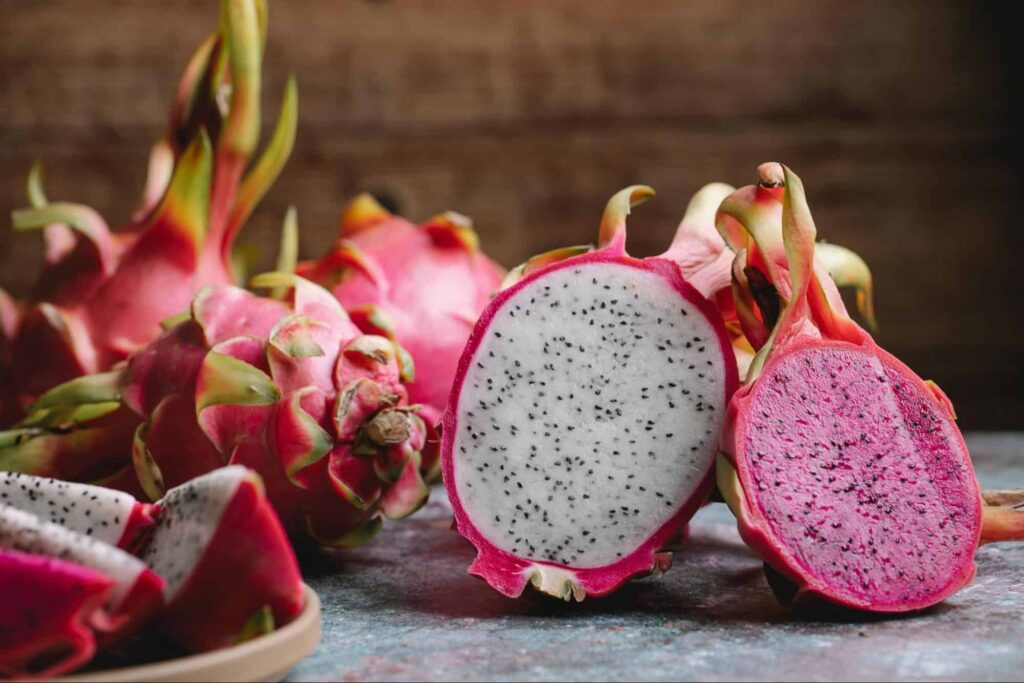
There’s a myth that fire-breathing dragons created the dragon fruit thousands of years ago. The fruit was the last thing that came out of a dragon’s mouth, and if anyone slew that dragon, the fruit was harvested and presented to the king as a symbol of victory.
As good as the myth sounds, the truth about where the dragon fruit came from can’t be any more straightforward but is still interesting.
Nowadays, dragon fruit can thrive in huge plantations, public gardens, and even indoors at different homes worldwide. One can easily buy this fruit from flea markets or health food stores.
What is the best climate for growing dragon fruit?
The dragon fruit is quite a hardy plant. Being a type of cactus, it isn’t surprising to know that this plant loves warm temperatures, water, and the sun.
Dragon fruit is the product of several cactus species endemic to Central and South America. However, it’s also cultivated in other tropical and sub-tropical world regions, including Southeast Asia and Oceania.
A dragon fruit plant should have at least six hours of exposure to the sun daily to survive. Therefore, a tropical climate like that of Thailand is best for growing dragon fruit.
The Dragon Fruit’s Many Looks and Names
Dragon fruit comes from many different species of cactus under the genus Selenicerus. Let’s take a look at three main varieties of these cacti below:
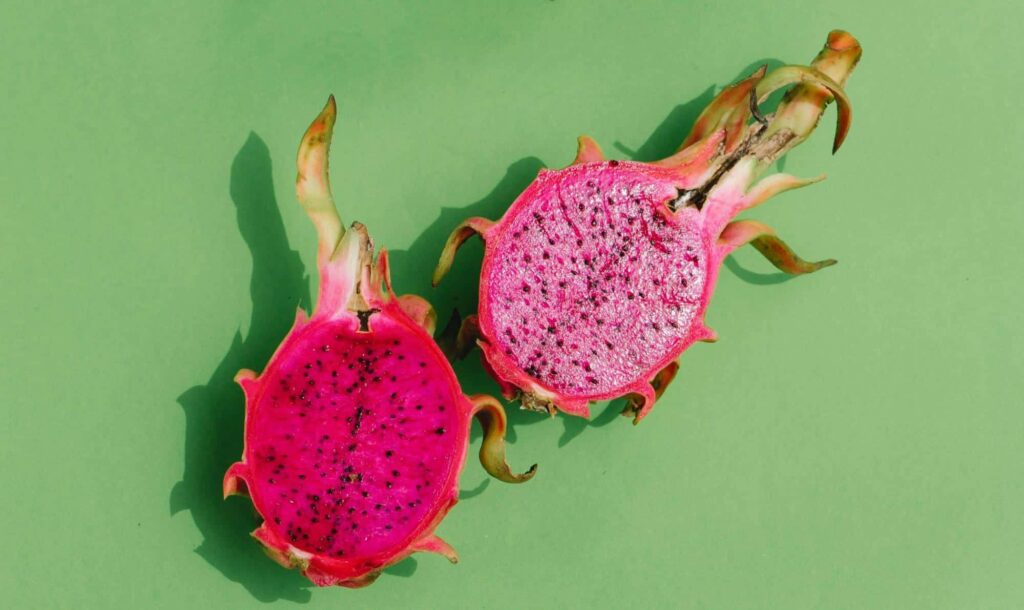 | Selenicereus costaricensis has a notable red skin with red or purple flesh. |
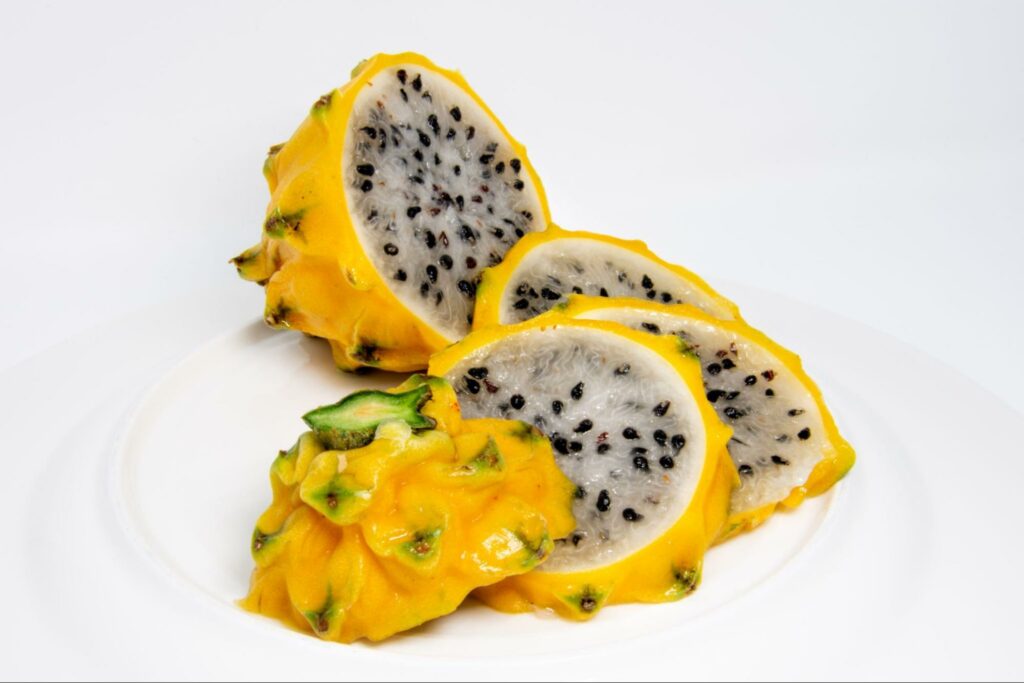 | Selenicereus megalanthus has yellow skin and white pulp. |
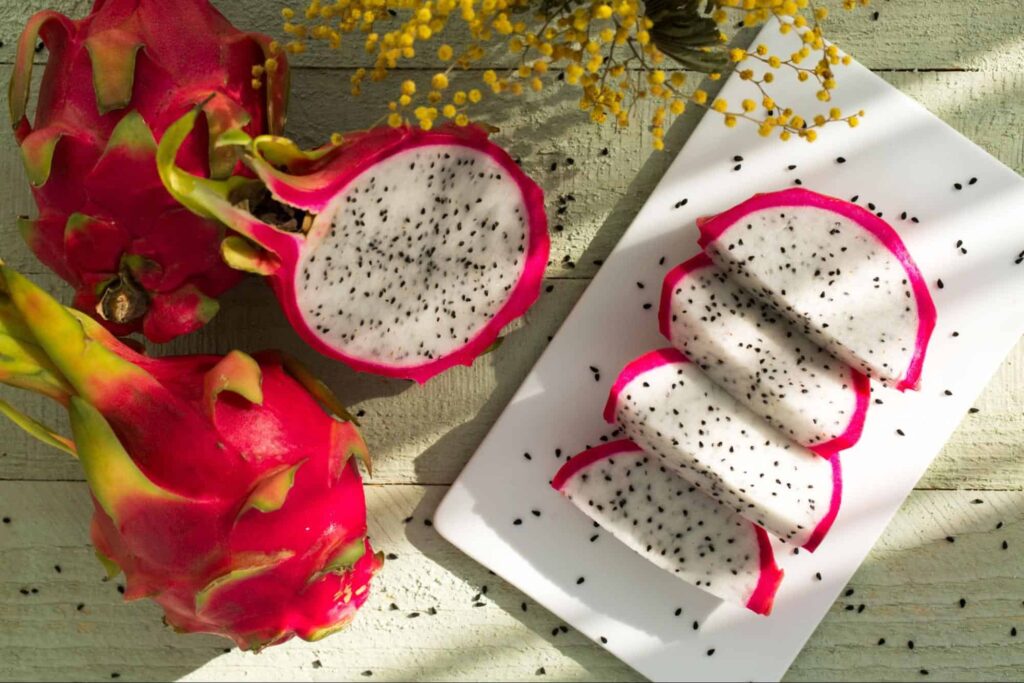 | Selenicereus undatus has pink skin with white flesh. |
All varieties of dragon fruit have black seeds embedded within the fruit’s flesh.
In addition to its looks, the dragon fruit plant (and produce) also come by many names. For one, dragon fruit is known as geow mangon in Thailand.
Here’s a list of all the other names the dragon fruit goes by:
- Moonlight cactus
- Night-blooming cereus
- Belle of the night
- Cactus fruit
- Strawberry pear
- Pitaya
- Pitahaya
Growing Dragon Fruit On Your Own
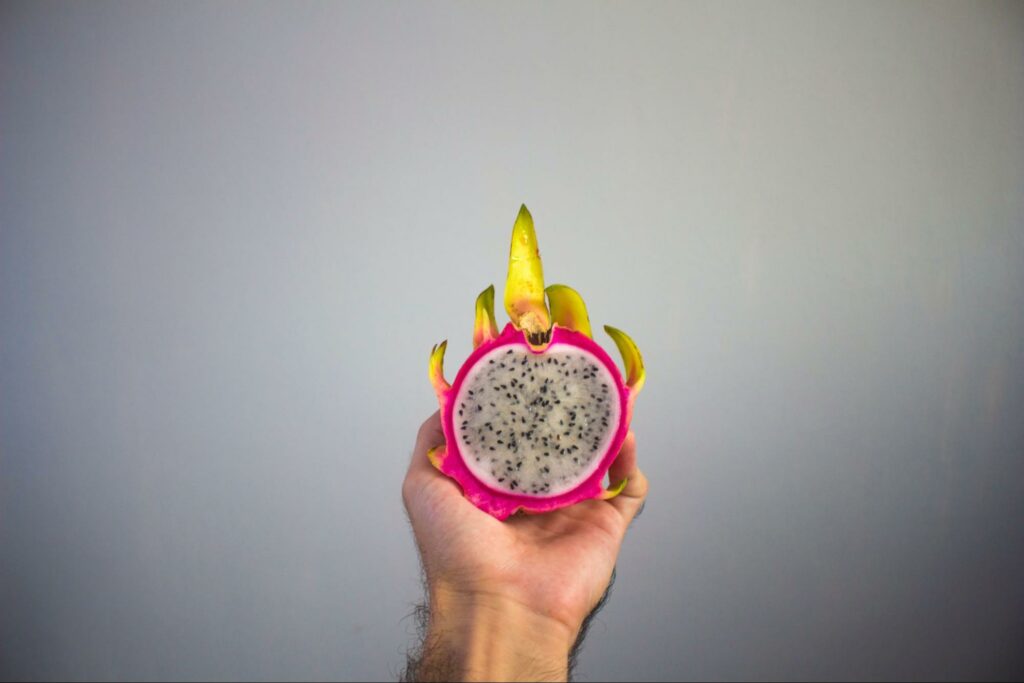
Growing dragon fruit can be pretty tricky. The greatest challenge to growing and harvesting those sweet, juicy, scaly fruits is the long time it takes for the plant to bear fruit.
But don’t fret! We’re sure you can do it even on your own; you’ll just need a green thumb and the following:
- Well-draining soil: This is essential so the dragon fruit’s roots won’t get waterlogged and begin to rot. This could be a plot of land or ground in a pot, but don’t use regular cacti soil because dragon fruit loves a bit more water.
- Lots of sunlight: As mentioned above, this cactus needs at least six hours of sunlight daily.
- Water and fertiliser: These keep any plant alive and thriving, and they’re also very much needed by a dragon fruit plant.
- Trellises or garden poles: Dragon fruit is a climber, so it needs something to hold onto and “climb” while growing to maturity.
When grown from seeds, dragon fruit will take five to seven years to flower and bear fruits. On the other hand, propagating the plant from stem cuttings will take a bit quicker — only one to three years.
We’ll teach you how to do either method of growing dragon fruit below, but first, let’s settle the biggest question that might be in your mind right now:
Should you grow dragon fruit indoors or outdoors?

You can grow dragon fruit either indoors or outdoors. However, it’s more advisable to grow the plant indoors, preferably in a greenhouse, if it’s in a colder climate.
However, there’s a catch to growing dragon fruit indoors. Once it flowers, you’ll need to pollinate it yourself because there will be no insects or other pollinators (that usually live outdoors) that would do so in an indoor environment.
On the other hand, growing dragon fruit outdoors also has challenges. Your plant will be at greater risk for weeds, pests, or animals that could physically damage or even kill it.
Maintaining the slightly acidic pH of the outside soil is challenging, too.
How to Grow Dragon Fruit from Seeds
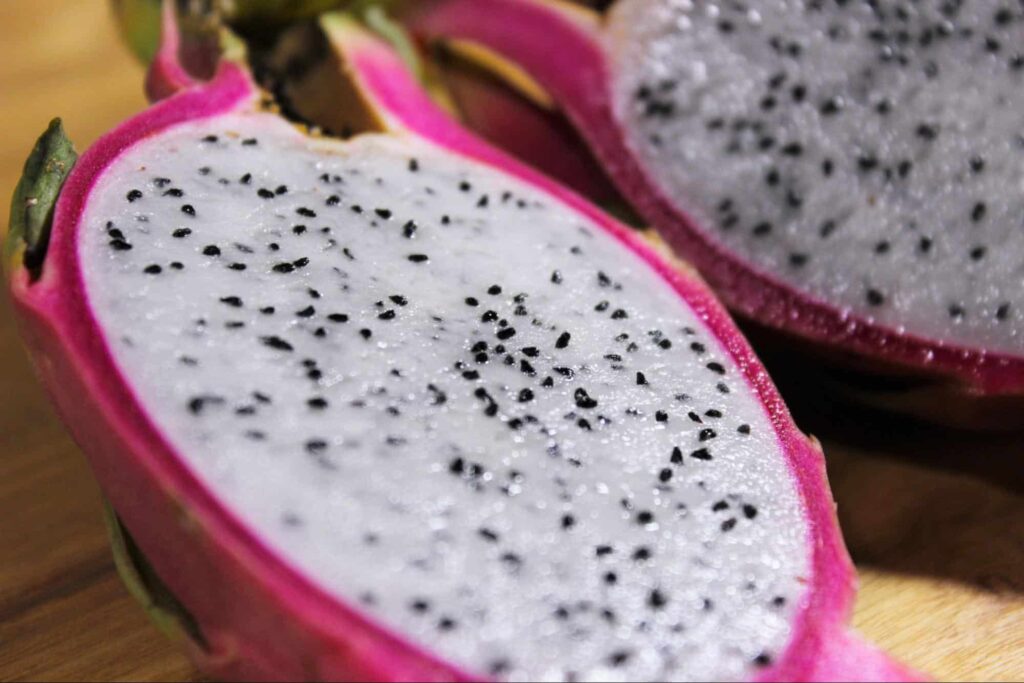
For growing dragon fruit from seeds, you’ll need an actual dragon fruit. Here’s how to turn this fruit into new plants:
- Get a dragon fruit. Any variety is acceptable.
- Open the fruit and scoop out its flesh. You can also just cut up the fruit into a couple of slices vertically, so you’ll just need to peel off the skin.
- Collect the dragon fruit seeds by pressing the fruit’s flesh through a fine sieve. You can also put a bowl under the sieve if you’d like to collect the pulp for use in drinks or smoothies.
- Wash the dragon fruit seeds under running water while they’re still in the sieve. Doing so will ensure that any extra pulp is removed — don’t worry if there is still some pulp left after since it won’t affect the seed’s growth when planted.
- Spread the washed seeds onto a moist paper towel. Leave them there for at least 12 hours.
- Prepare your indoor or outdoor soil. Growing dragon fruit can be done either indoors in pots or outdoors straight in your garden.
- Sprinkle the seeds over the soil surface. Cover with another thin layer of soil.
- Water regularly or keep the soil moist. Do not let the soil dry up; You must maintain its moisture consistently while you wait for the seeds to sprout.
- Transplant any seedlings into bigger and more permanent places. Keeping seedlings in a crowded area will lead each seedling to fight one another for nutrients and water.
- Support growing dragon fruit plants with trellises or garden posts. Since this cactus “climbs,” it will need structural support once it reaches a height of 30 cm (12 in).
How to Grow Dragon Fruit from Cuttings

Growing dragon fruit from its cuttings is an easier and quicker method than starting from seeds.
You’ll just need to get a 12-inch (30 cm) cutting from a mature donor or “mother” dragon fruit plant, and you’re all set to do the rest of these steps:
- You can divide your 12-inch (30 cm) cutting into three or four smaller pieces. Just make sure to note which part of every cutting fanned out further from the mother plant’s base; this is essential information for later.
- Leave your cutting in a warm and dry location for a few days. This procedure lets the cutting “heal” or form a whitish callus over the part where you cut it off from its mother plant.
- Plant your cuttings into the soil. Ensure that each cutting is an inch or two (2.5 to 5 cm) below and is planted upright with the end that used to be furthest from the base of the mother plant sticking out.
- Water or keep the soil moist regularly for three to four weeks. Like growing with seeds, consistent moisture is essential for the cuttings to grow roots.
- Transplant the rooted cuttings into pots if you’ll grow them indoors. You can skip this step if you plan to grow your dragon fruit outdoors.
- Support the growth of your dragon fruit plant. You can use gardening posts or trellises since the dragon fruit will climb as it grows.
How to Take Care of a Dragon Fruit Plant

You should learn to do what your growing dragon fruit plant needs daily, like watering, pruning, and fertilising the soil.
It’s also great if you’re familiar with plant diseases or pests that could affect the plant’s production of dragon fruits or kill it. This knowledge will inform you of the warning signs of any sickness or infestation your dragon fruit might get.
Routine Upkeep
Dragon fruit is quite different from typical cacti because it loves a little bit more moisture. This love of water brings us juicy fruits, so we’re not complaining!
So, for the routine upkeep of your dragon fruit plant, keep the soil it’s planted in moist enough. Don’t let the soil dry out cracking but don’t overwater it as well.
If you are growing dragon fruit for its fruit, using fertiliser is essential.
You can spread fertiliser pellets or spray the soil with a fertiliser that has a balanced NPK (nitrogen-phosphorus-potassium) ratio like 10-10-10 or 12-12-12. Do this once a month or every two months.
Although the dragon fruit is a type of cactus, it will still die if subjected to extreme temperatures. The ideal environment for this plant should be around 70 °F (21 °C).
Make it a point to regularly prune or cut off excess stems and foliage from your dragon fruit plant. Because the dragon fruit can grow as high as 20 feet (6 meters), there will be lots of stems out of this giant!
If you feel there is already overcrowding of stems or roots in one area, trust your intuition and trim them off.
Trimming or pruning will help your plant grow better because it makes the plant redistribute nutrients and effort in developing new stems that could produce more fruit. Pruning also helps in managing any plant disease in its early stages.
Dragon Fruit Plant Pests and Diseases

Dragon fruit isn’t a stranger to getting plant disease. Three typical conditions affect this plant’s life and fruiting ability.
- Anthracnose: This is one of the most common diseases of the dragon fruit caused by the bacteria Colletotrichum spp. It shows reddish brown spots with yellow outer rings that affect fruit quality and quantity.
- Fruit rot: This disease is caused by bacteria like Xanthomonas campestris and Erwinia carotovora, but plant calcium deficiency has also been found to worsen this condition. It presents as tan spots that turn black and make fruits rot.
- Stem canker: This disease is caused by the fungus N. dimidiatum. Stem canker is considered the most destructive disease of dragon fruit because the fungus (and its lesions) can spread quickly and even destroy dragon fruit plantations.
Once you notice symptoms of any of these three diseases, the best action is to get rid of the “sick” or affected parts of the dragon fruit and use fungicides on the soil and your plant.
If unfortunately, the disease’s damage is too severe, you’ll need to let go of your diseased plant. Ask your local garbage disposal authority how to properly do so to prevent unwittingly spreading the plant disease to other areas.
How to Harvest Dragon Fruit
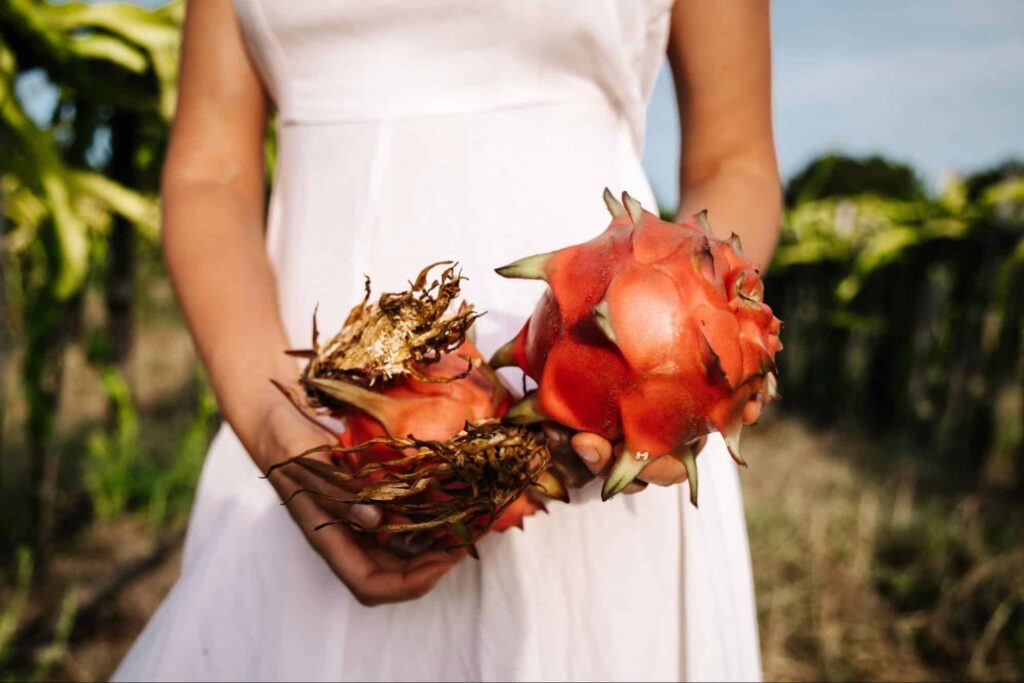
A dragon fruit’s beautiful flower only blooms for one day (or night, if you want to be precise). It will wither the next day and start forming the fruit if it gets pollinated.
After this, you’ll just need to wait for around 27 to 33 days before harvesting its fruit. Unripe dragon fruit will still have green skin — its colour changes to red or yellow (depending on the variety) as it ripens.
The goal is to harvest the dragon fruit approximately four days after its colour has changed to make sure that its ripeness is just right.
You’ll know that you have perfectly ripe dragon fruit when:
- The “wings,” or the small leaves extending from the fruit, have just started to wither or dry out.
- The fruit, when pressed lightly, is soft but not mushy.
- You can easily remove the fruit from its stem with a few twists.
Dragon fruit is overripe if it’s:
- Mushy when squeezed
- Has fallen off the plant by itself
- Is attached to a dead or dry stem
As a safety precaution, you can harvest dragon fruit wearing gloves. The fruit can have prickly thorns, so be ready with a pair of gardening shears to remove them.
If you want to see the technique used by actual farmers in harvesting dragon fruit, check out this video:





